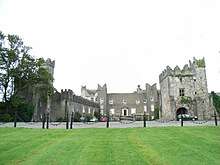Robert St Lawrence, 3rd Baron Howth
Robert St Lawrence, 3rd Baron Howth (born c.1435 – died before 1488) was a leading statesman in 15th-century Ireland who held the office of Lord Chancellor of Ireland. Through marriage he was a close connection of the Tudor dynasty.
Background
He was born about 1435, the eldest son of Christopher St Lawrence, 2nd Baron Howth. There is some dispute about the identity of his mother: some sources name her as Anne Plunkett, others as Elizabeth Bermingham. He succeeded to the title in 1464 or 1465.
Career
O'Flanagan calls him "a nobleman of considerable abilities, who filled several offices connected with the Government of Ireland." [1]
He was High Sheriff of County Dublin in 1456, Chancellor of the Exchequer of Ireland in 1478 and Clerk of the Court of Common Pleas (Ireland). In 1474 he was chosen to be one of the thirteen Knights of the Brotherhood of Saint George, who were charged with defending the Pale against invasion by neighbouring Gaelic clans, and with keeping the peace in the Pale generally.

In 1483 Richard III chose him to be Lord Chancellor of Ireland, despite opposition from Gerald FitzGerald, 8th Earl of Kildare, who was then almost all-powerful in Ireland. His continued employment by the Yorkist kings after his second marriage in 1478 is surprising, given that his second wife Joan Beaufort was a close relative of Henry Tudor, who was to overthrow the House of York in 1485. In any event his tenure as Lord Chancellor was short, ending either with his removal or his death. His probably took place later in 1483, although some sources place it as late as 1487.[2]
Family
Robert married firstly Alice White, daughter of Nicholas White of Killester, and by marriage acquired the manor of Killester. In 1478 he made a second and politically significant marriage to Joan Beaufort, daughter of Edmund Beaufort, 2nd Duke of Somerset and Eleanor Beauchamp. Somerset's seemingly remote claim to the English Crown as the legal heir of John of Gaunt was inherited by his cousin Margaret Beaufort's son Henry VII, who became first Tudor monarch. The St Lawrences, unlike most of the Anglo-Irish nobility, were reliable supporters of the Tudor dynasty: clearly the family connection was too valuable to them not to be taken full advantage of.

He had six children:
- Nicholas St Lawrence, 4th Baron Howth
- Thomas St. Lawrence, who became Attorney General for Ireland and a judge of the Court of King's Bench (Ireland)[3]
- Walter
- Christopher
- Genet, who married Thomas Fitzsimons
- Anne, who married William Golding.
Some sources state that his second marriage was childless, however his eldest son Nicholas, who was born about 1460, must have been about twenty years older than his second son Thomas, who was studying law at the Inns of Court in London in 1503 and survived until 1553, so it is likely that Thomas, Walter and Christopher were children of their father's second marriage to Joan Beaufort. Joan remarried Sir Richard Fry and died in 1518.
References
- O'Flanagan, J. Roderick. Lives of the Lord Chancellors and Keepers of the Great Seal of Ireland 2 Volumes London 1870
- Ball, F. Elrington The Judges in Ireland 1221-1921 John Murray London 1926
- Burkes Peerage